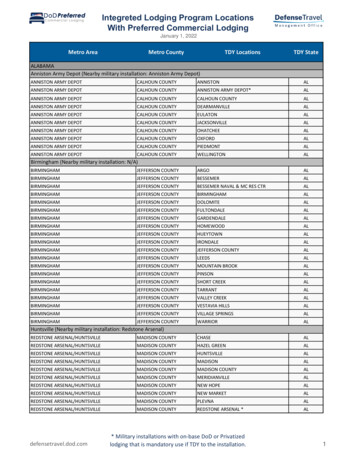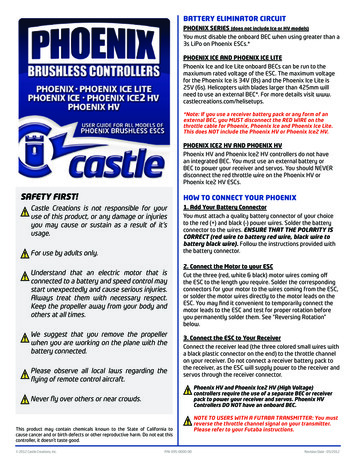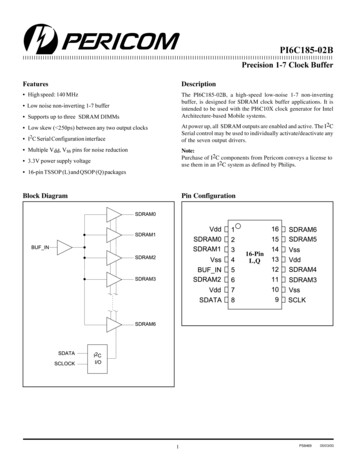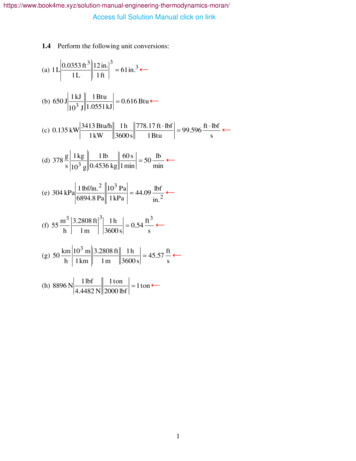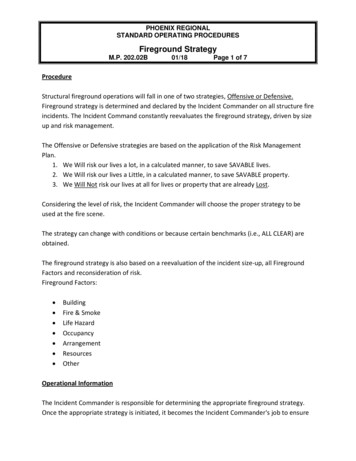
Transcription
PHOENIX REGIONALSTANDARD OPERATING PROCEDURESFireground StrategyM.P. 202.02B01/18Page 1 of 7ProcedureStructural fireground operations will fall in one of two strategies, Offensive or Defensive.Fireground strategy is determined and declared by the Incident Commander on all structure fireincidents. The Incident Command constantly reevaluates the fireground strategy, driven by sizeup and risk management.The Offensive or Defensive strategies are based on the application of the Risk ManagementPlan.1. We Will risk our lives a lot, in a calculated manner, to save SAVABLE lives.2. We Will risk our lives a Little, in a calculated manner, to save SAVABLE property.3. We Will Not risk our lives at all for lives or property that are already Lost.Considering the level of risk, the Incident Commander will choose the proper strategy to beused at the fire scene.The strategy can change with conditions or because certain benchmarks (i.e., ALL CLEAR) areobtained.The fireground strategy is also based on a reevaluation of the incident size‐up, all FiregroundFactors and reconsideration of risk.Fireground Factors: BuildingFire & SmokeLife l InformationThe Incident Commander is responsible for determining the appropriate fireground strategy.Once the appropriate strategy is initiated, it becomes the Incident Commander's job to ensure
PHOENIX REGIONALSTANDARD OPERATING PROCEDURESFireground StrategyM.P. 202.02B01/18Page 2 of 7that all personnel are operating within the correct strategy. By controlling the firegroundstrategy, the Incident Commander is providing overall incident scene safety. The properstrategy will be maintained by the following actions: Avoiding simultaneous OFFENSIVE and DEFENSIVE strategies in the same fire area. Thistypically happens by first committing personnel to interior positions, then operatingmaster streams from exterior positions, which places interior crews in danger of injuryor death.Matching the appropriate strategy to the fire conditions of the structure and minimizingrisk to fire fighters.Managing fireground strategy must start with the arrival of the first unit and be constantlymonitored and evaluated throughout the entire incident. The initial Incident Commander willinclude the fireground strategy in the on‐scene report. As Command is transferred to laterarriving officers, these officers assuming Command must reevaluate the fireground strategybased on the Risk Management Plan.Fireground strategy provides a starting point for fireground operations. Once the strategy isannounced, all firefighters know whether to operate on the interior or exterior of the building.The fireground strategy cannot be a mystery, everyone operating on the fireground must beoperating in the same strategy mode (Offensive or Defensive).Offensive StrategyCommercial and residential fires require a thorough size up, assessment of life safety, andconsideration of the Risk Management Plan. Once it is determined that an offensive attack issafe and appropriate, a smart and deliberate execution of the tactical objectives will be
PHOENIX REGIONALSTANDARD OPERATING PROCEDURESFireground StrategyM.P. 202.02B01/18Page 3 of 7conducted. The following are guidelines for offensive fire attacks once size up has beencompleted and offensive strategy has been determined:1. Assume Command2. Address 2 in / 2 out decision prior to entry.3. Initial attack efforts must be directed toward supporting a primary search. This mayrequire rescuers to go to obvious victims or to manage the hazard and extinguish thefire. The first attack line must go where it can best affect this mission and its placementis dependent upon the variables present on the fireground, determine fire conditionsand extent before starting fire operations (as far as possible). Gather 360 ofinformation; identify the flow path and the most likely location of the fire and survivableenvironments for victims. Search, rescue and fire attack are simultaneous operations.4. Offensive fires should be fought aggressively, with rapid and effective size up. Quicklyidentify conditions in the occupancy and apply the quickest, most appropriate, water tothe fire.5. Keep the building openings closed if possible to reduce ventilation of the fire until youhave a charged hose line in place and are prepared to make entry.6. *Before making entry* When possible reset or darken down the fire using a straightstream applied to the ceiling of the fire compartment. 15‐30 seconds of water applied inthis manner will dramatically reduce temperatures and improve tenability throughoutthe occupancy. This tactic must be followed by an aggressive interior attack to completefire extinguishment and evacuate any victims.7. Make every effort to enter the structure at the air intake side of the flow path. You wantthe air at your back as you make entry. This will reduce the likelihood of being caught inthe flow path.8. Co‐ordinate all ventilation of the structure to ensure effectiveness and improvement ofinterior conditions.
PHOENIX REGIONALSTANDARD OPERATING PROCEDURESFireground StrategyM.P. 202.02B01/18Page 4 of 7Companies must maintain situational awareness and resist the urge to focus only on the fire(this is known as the "candle moth" syndrome or "tunnel vision"). In some cases, the mosteffective tactical analysis involves an evaluation of what is not burning rather than what isactually on fire. The unburned portion represents where the fire is going and should establishthe framework for fire control activities and requirements.Command must consider the most critical direction and avenues of fire extension, plus itsspeed, particularly as they affect: Rescue activitiesLevel of risk to firefightersConfinement effortsExposure protectionCommand must allocate personnel and resources based upon this fire extension/spreadevaluation.Command must not lose sight of the very simple and basic fireground reality that at some pointfirefighters must engage and fight the fire. Command must structure whatever operations arerequired to put water on the fire. The rescue/fire control‐extension/exposure problem is solvedin most cases by a fast, strong, well‐placed attack. Command must establish an attack plan thatoverpowers the fire with actual water application, either from offensive or defensive positions.Command must consider the seven sides (or sectors) of the fire: front, rear, both sides, top,bottom, and interior. Fires cannot be considered under control until all seven sides areaddressed. Failure to address all seven sides will frequently result in fire extension.Where the fire involves concealed spaces (attics, ceiling areas, construction voids, etc.), itbecomes paramount that companies identify and operate fire streams into such areas. Earlyidentification and response to concealed space fires will save the building. Officers who hesitateto gain access to concealed spaces because they don't want to beat up the building may losethe entire structure.Early coordinated ventilation is a major support item that must be addressed during concealedspace attacks. Ventilation must be initiated early and be well coordinated with interior crews.Ventilation openings should be made in the fire area.
PHOENIX REGIONALSTANDARD OPERATING PROCEDURESFireground StrategyM.P. 202.02B01/18Page 5 of 7Command must “get ahead” of the fire. Command must make critical decisions that relate tocutoff points and develop a pessimistic fire control strategy. It takes a certain amount of time toget water to a location, and the fire continues to burn while the attack is being set up.Command must consider where the fire will be when attack efforts are ready to go intooperation; if misjudged, the fire may burn past the attack/cutoff position before resources andpersonnel are in position. Do not play "catch up" with a fire that is burning through a building.Project your set‐up time, write off property and get ahead of the fire. Set up adequately aheadof the fire, then overpower it.Write‐off property that is already lost and go on to protect exposed property based on the mostdangerous direction of fire spread. Do not continue to operate in positions that are essentiallylost.The basic variables relating to attack operations involve: Location/position of attackSize of attackSupport functionsCommand develops an effective attack through the management of these factors. Commandmust balance and integrate attack size and position with fire conditions, risk and resources.Many times, offensive/defensive conditions are clear cut and Command can quickly determinethe appropriate strategy. In other cases, the conditions are Marginal, and Command mustclearly communicate these conditions.A Marginal situation is defined as defensive conditions with a known rescueA Marginal situation has a very short window to affect a rescue or to discontinue the attemptand begin a defensive fire attack.Strategy changes can develop almost instantly or can take considerable time. Command mustmatch the strategy with the conditions. The Incident Commander controls overall incidentscene safety by determining the proper strategy and subsequently the proper tactics to beused.
PHOENIX REGIONALSTANDARD OPERATING PROCEDURESFireground StrategyM.P. 202.02B01/18Page 6 of 7If the Incident Commander doesn't change strategies from offensive to defensive until thebuilding is disassembling itself due to structural damage, Command is late in strategydetermination and on the receiving end of the building's decision governing the new strategy tobe employed. Often times when the building gets to make those decisions, fire fighters becometraumatized (physically and/or emotionally). The Incident Commander determines the strategy,the building should not.Command needs to constantly evaluate conditions while operating in marginal situations. Thisrequires frequent and detailed reports from Sector Officers.It is imperative that Command assign a Roof Sector as early as possible during marginalsituations for rapid evaluation of roof conditions. In certain situations, Command shouldstrongly consider not committing crews to the interior of a structure unless he/she receives areport from Roof Sector that the roof of the structure is safe to operate on and under. It isbetter to go from an offensive to a defensive strategy too soon rather than too late.Defensive StrategyThe decision to operate in a defensive strategy indicates that the offensive attack strategy, orthe potential for one, has been abandoned. The elements of an effective defensive strategyalways include: Identify what is lostWrite it offProtect exposuresThe announcement of a change to a defensive strategy will be made as Emergency Traffic andall personnel will withdraw from the structure and maintain a safe distance from the building.Captains will account for their crews and advise their Sector Officer on the status of their crew.Sector Officers will notify Command of the status of the crews assigned to their sector. A PAR(Personnel Accountability Report) shall be obtained after any switch from offensive todefensive strategy.
PHOENIX REGIONALSTANDARD OPERATING PROCEDURESFireground StrategyM.P. 202.02B01/18Page 7 of 7Interior lines will be withdrawn and repositioned when changing to a defensive strategy. Crewsshould retreat with their hose lines if safe to do so. If retreat is being delayed because of hoselines, and it is unsafe to stay in the building, hose lines should be abandoned.All exposures, both immediate and anticipated, must be identified and protected. The ability toprotect these exposures from any appropriate position must be assessed and coordinated. Thismust match the overall strategic level incident size‐up and position in the risk managementplan.An attempt to control the main body of fire is critical. This may be the best thing to assist inprotection of exposures.Master streams are generally the most effective tactic to be employed in defensive operations.For tactical purposes, a standard master stream flow of at least 750 GPM should be theguideline. Adjustments may be made upward or downward from this figure, but it is verysignificant in the initial deployment of master streams.When the exposure is severe, and water is limited, the most effective tactic is to put water onthe exposure. Once exposure protection is established, attention may be directed to knockingdown the main body of fire and thermal column cooling. The same principles of large volumewater application should be employed.“FIRE UNDER CONTROL” means the forward progress of the fire has been stopped and theremaining fire can be extinguished with the on‐scene resources; it does not mean the fire iscompletely out. When the fire is brought under control, Command will notify Alarm utilizing thestandard radio report of "FIRE UNDER CONTROL" and alarm will record the time of this report.Command must initiate a PAR report from all sectors and crews.If defensive operations are conducted from the onset of the incident, Command will notifyAlarm that there will not be a primary search completed for the affected structure(s).
up and risk management. The Offensive or Defensive strategies are based on the application of the Risk Management Plan. 1. We Will risk our lives a lot, in a calculated manner, to save SAVABLE lives. 2. We Will risk our lives a Little, in a calculated manner, to save SAVABLE property. 3.

